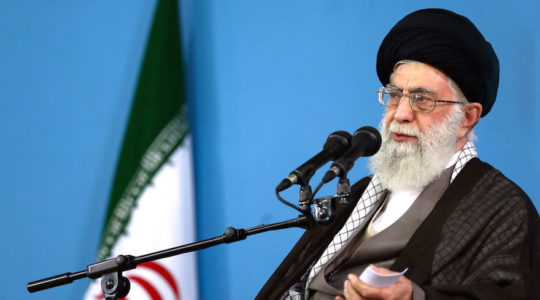BUDAPEST, Hungary (JTA) — Peering through dusty apartment widows isn’t an uncommon pastime in this capital city’s crime-infested 8th District, with its many drug addicts and alcoholics seeking for a fix.
But Adam Schoenberger wasn’t scouting for a place to rob on his peeping tour of the district earlier this month.
An activist who recently moved his Jewish organization’s headquarters into the neighborhood to save on rent, Schoenberger was looking for the small apartment synagogues that persist in the area despite its few Jewish residents.
Eventually Schoenberger spotted a Star of David hanging on the wall of a ground-floor apartment on Nagyfuvaros Street. Around the corner he found another small synagogue behind a heavy, locked metal gate.
The synagogues are maintained by Mazsihisz, the umbrella group of Hungarian Jewish communities, which controls hundreds of little-used real-estate assets across Hungary. The synagogue on Nagyfuvaros Street serves a congregation of fewer than 20 people. A nearby shul on Teleki Ter normally opens on Shabbat, though not always with the prayer quorum of 10 Jewish men.
“Some of the money that maintains inactive synagogues and other heritage real estate would have much more impact if it were spent on supporting the grassroots Jewish scene, which lacks the funding to really blossom,” Schoenberger said.
To Schoenberger, the community’s continuing support for such synagogues — not to mention some 1,300 cemeteries across the country — reflects the misplaced priorities of Hungary’s Jewish leadership, which preserves such facilities even as it provides little support for the country’s vibrant Jewish youth scene.
Schoenberger is a founder of Marom, whose 13 employees and network of 100 volunteers operate the Budapest bar and cultural center Siraly, run an annual Jewish festival and does outreach to the beleaguered Roma minority in Hungary, yet receive no funding from the local Jewish community. Marom and other such groups rely on donations from abroad to survive.
Mazsihisz’s president, Andras Heisler, declined to answer questions from JTA about the organization’s funding priorities. But Rabbi Zoltan Radnoti of the Bet Shalom congregation in Budapest and a Mazsihisz employee said the umbrella group has not supported Marom because it doesn’t exclude non-Jews from its programming.
Radnoti said the Mazsihisz mandate is to cater only to Jews.
“Mazsihisz cannot check if someone at B’nai B’rith or Siraly are Jewish,” he said. “There are some non-Jews that enter among Jews because it’s fun, and that’s fine. But Mazsihisz doesn’t want to give money to such activities.”
Since the fall of communism, Hungary’s Jews have struggled to manage hundreds of properties confiscated during the Holocaust that were returned after the fall of the regime.
According to a 2010 report by the Israeli Knesset‘s research department, the Hungarian government gave Mazsihisz at least 100 properties following the passage of a 1991 law on communal restitution. The Mazsihisz list of rural cemeteries comprises 1,304 graveyards.
A prominent communal figure told JTA that maintenance and taxes on returned properties amounts to a few hundred thousand dollars annually, though Mazsihisz would not confirm the figure.
Hungary is not the only post-communist country with a relatively poor Jewish population coping with vast assets inherited from a time when the community was much larger. But unlike Slovakia, Romania and other former communist countries that are home to fewer than 10,000 Jews, Hungary has 100,000 Jews — the largest community in central Europe — and its younger generation is increasingly demanding greater investment in activities that meet their needs.
Marom, which is about to reopen Siraly after it was closed down by the city last year because it was operating out of an illegal squat, is one of the major players in Budapest’s Jewish youth scene. Also active in the capital is the Israeli Cultural Institute, which promotes cultural exchange between Israel and Hungary; Haver Foundation, an informal Jewish education platform; and Minyanim, which conducts tours of Budapest, cultural events and conferences for young Jews.
None receive funding from Mazsihisz. The reopening of Siraly was made possible by a $75,000 grant from the Jewish Federations of North America.
“The Moishe House, Marom — none of us are supported by the local Hungarian Jewish community,” said Tomi Buchler, the director of Minyanim, which receives funding from the Jewish Agency for Israel.
Meanwhile, the Mazsihisz youth division is largely inactive, according to several sources. Its former director, Mate Feldmajer, had to resign last year after saying that gays were not welcome on the Mazsihisz board, a statement that drew furious reactions from several grassroots Jewish organizations.
Mazsihisz does, however, operate large synagogues in cities like Vac and Gyongyos, where very few Jews live and where worshipers rarely reach a prayer quorum.
“It is important to show a presence in such places, which are part of who we are,” Radnoti said.
Buchler is one of several young Hungarian Jewish activists advocating greater investment in the needs of younger Jews as well as outreach to non-Jews, but he recognizes the sensitivity of the dilemma.
“My own great-grandparents are buried in cemeteries managed by Mazsihisz,” Buchler said. “Our heritage sites are part of our story. And if Mazsihisz won’t take care of our heritage sites, then no one will.”
The tension around communal resources led Buchler to help organize a conference last month about the issue. Sponsored by the Washington-based Charles and Lynn Schusterman Family Foundation, the From Me to We conference gathered dozens of young Jewish activists in Budapest for sessions on how to reconcile the competing commitments in Hungary and elsewhere, as part of the Foundation’s global Connection Points program.
The discussions come amid a larger debate about reforming Mazsihisz policies and finances in the wake of a recent shakeup that saw Peter Feldmajer, the group’s former president, replaced by Heisler. Shortly after, Gusztav Zoltai, who had served for decades as the organization’s all-powerful director, resigned in what was widely seen as a forced retirement connected to alleged financial irregularities, though Heisler denies this.
“For the first time in a long time, there is a chance for change, but it will be gradual and slow,” said Mircea Cernov, CEO of the Haver Foundation. “It will take time to change the current distribution of resources within the Jewish community, which is designed to resist change instead of encouraging development and growth.”
Buchler is hoping for a more radical change, one that will do more than just redistribute community funds. His organization is working to instill a culture of giving in a country where years of corruption and militant communism have left many with a cynical attitude toward social altruism.
“Heritage preservation is done with the government’s money and young Jewish groups operate on funding from abroad, but almost nothing is coming from the community itself,” Buchler said. “We need to focus on changing that through instilling financial transparency. The rest will follow.”
JTA has documented Jewish history in real-time for over a century. Keep our journalism strong by joining us in supporting independent, award-winning reporting.





